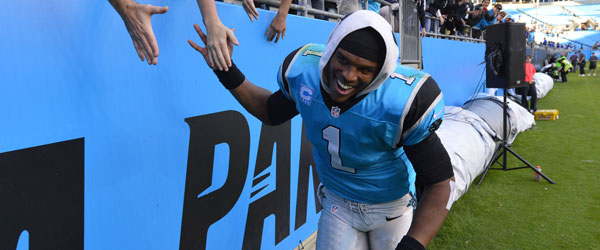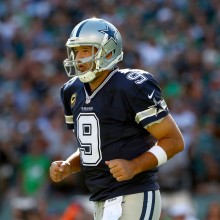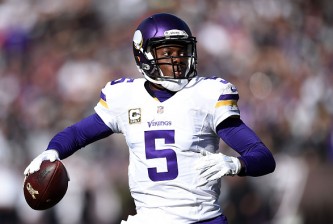
Cam Newton has arrived, and he's done so in the most ironic way possible.
Lauded for the unprecedented athleticism he exhibited at 6'5'' and 250 pounds during one magical, national title-winning season at Auburn in 2010, there was no telling what Newton was capable of as a scrambling, improvising, plow-you-over quarterback at the NFL level.
His size was menacing, his delivery was straight from the textbook, and the strength of his arm left nothing to be desired.
But he was deemed raw as a passer, lacking the specialized abilities to decipher coverages, quickly react to them and consistently make accurate throws to the right receiver—you know, the fine details of quarterbacking that made guys like Tom Brady, Drew Brees, Aaron Rodgers and Peyton Manning better than everyone else.
In essence, Newton was, undeniably, an immaculate physical mold of a quarterback with transcendent movement skills for his position. But questions lingered about his lack of polish in the area most vital to succeeding as a signal-caller—throwing from the pocket.
Upon entering the NFL, he silenced his doubters…quickly. In his professional debut, he completed 24-of-37 passes for 422 yards, one interception, two touchdowns through the air and another on the ground. But the Carolina Panthers lost 28-21 to the Arizona Cardinals after blowing a lead in the fourth quarter.
His dazzling maiden performance was message-sending, and ultimately became a microcosm of Newton's record-setting rookie season.
He threw for 4,051 yards at a 60 percent completion rate with 21 touchdowns and 17 interceptions all while adding 14 rushing touchdowns. But on five occasions, his team held a lead in the fourth quarter that it ultimately squandered.
After not losing a game in two years on the collegiate level—at junior college in Texas and at Auburn—Newton's noticeably disappointed post-game behavior made many believe he wasn't cut out to take his lumps and eventually become a leader in the NFL. However, those same people admitted they might have been wrong about his football-throwing proficiency.
In 2012, Newton experienced a watered-down version of 2011 from a statistical standpoint. His completions, attempts, completion percentage, passing yards, and rushing touchdown total all decreased. His touchdown-to-interception ratio improved only slightly to 19:12, and his Panthers continued to falter late. They lost four games in which they had a fourth-quarter lead and another sub-.500 record was to show for it.
So, Newton wasn't able to bring his team to new heights as a prolific, gun-slinging quarterback as a rookie, and his minimal regression as a sophomore lent credence to the thought that his 2011 campaign was an aberration.
Although there's a growing faction of people who realize wins and losses shouldn't define a signal-caller, with the heightened importance of the position in the increasingly pass-happy NFL, at some point, to gain the respect of the media and fans, you have to win as a quarterback.
But this year, Newton's answered all the questions. The critics are mum. He's become traditionally refined in a way that's helped him reach his full potential to thrive at the game's most critical position. Oh, and his Panthers are winning. After a victory over the Tampa Bay Buccaneers in Week 8, Carolina was over the .500 mark for first time since 2008.

And he hasn't done it with an abundance of jaw-dropping, juke-filled scampers, 80-yard bombs that put his tremendous arm strength on full display or power runs at the goal line.
He's done it as a masterful pocket passer.
Regardless of athletic prowess, and the never-before-seen ability to make like a running back in the open field, quarterbacks, at some point, must become deadly from the pocket. That goes for Robert Griffin III, Russell Wilson and Colin Kaepernick, as well, guys, who technically, are close descendants of Newton's dual-threat quarterbacking ways.
Heck, ask Steve Young, Randall Cunningham and John Elway about that. And Michael Vick.
Pro Football Focus has a stat called Accuracy Percentage, which is basically the more intelligent older brother of completion percentage. It discounts drops, throwaways, spikes and passes when a quarterback is hit as he throws.
It's the best measure of a signal-caller's true accuracy.
In 2011, Newton's Accuracy Percentage was 68.2. Among the 36 quarterbacks who took at least 25 percent of their respective team's dropbacks that year, 68.2 ranked him 26th. In 2012, his Accuracy Percentage was 68.5, which ranked him 31st out of 38.
Heading into Week 10, Newton's Accuracy Percentage has inflated to 74.8, which ranks him 8th out of 38 qualifying candidates.
More specifically, Newton has an Accuracy Percentage of 75 when "under pressure," a mark that leads the entire NFL. It was 58.0 in 2012 and 58.9 in 2011.
In elementary terms, the Panthers quarterback is completing 64.1 percent of his passes, easily the highest percentage in his career. He's harnessed his cannon arm and transformed it into a relatively pinpoint accurate laser beam.
Newton's on pace for the lowest passing-yard total of his career but the best touchdown-to-interception ratio. He's on pace for the fewest rushing attempts of his career, and his yards-per-carry average is down.
Sure, he's made a defender miss here and there and hasn't shied away from opportunities to run when they've presented themselves. But his advancement as a passer has been the impetus of his legitimate "arrival" as a franchise quarterback.
The team around him as gotten a bit better, and he's feasted on a somewhat soft schedule of late, but Cam Newton is finally winning and has finally realized that in order to be considered among the elite quarterbacks, no matter how flashy his athleticism may be, throwing the ball accurately will never, ever go out of style in the NFL.























